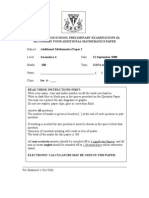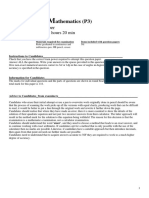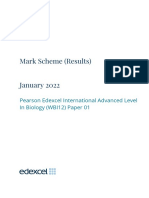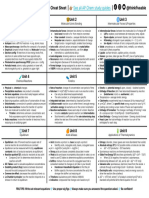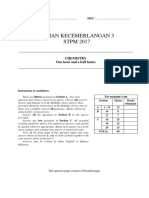Muf0041 Chemistry Unit 1: Skills and Application Task - Sample Test 3 March Intake 2021 (20% of Unit Mark)
Muf0041 Chemistry Unit 1: Skills and Application Task - Sample Test 3 March Intake 2021 (20% of Unit Mark)
Uploaded by
CYCopyright:
Available Formats
Muf0041 Chemistry Unit 1: Skills and Application Task - Sample Test 3 March Intake 2021 (20% of Unit Mark)
Muf0041 Chemistry Unit 1: Skills and Application Task - Sample Test 3 March Intake 2021 (20% of Unit Mark)
Uploaded by
CYOriginal Title
Copyright
Available Formats
Share this document
Did you find this document useful?
Is this content inappropriate?
Copyright:
Available Formats
Muf0041 Chemistry Unit 1: Skills and Application Task - Sample Test 3 March Intake 2021 (20% of Unit Mark)
Muf0041 Chemistry Unit 1: Skills and Application Task - Sample Test 3 March Intake 2021 (20% of Unit Mark)
Uploaded by
CYCopyright:
Available Formats
MONASH UNIVERSITY
FOUNDATION YEAR
MUF0041 CHEMISTRY UNIT 1 Name:
Student ID:
Date:
Teacher:
Skills and Application Task – Sample Test 3 March Intake 2021
(20% of Unit mark)
Specifications
Task Type Test
▪ 15 Multiple Choice (50%)
▪ 3 Short Answer (50%)
Scope of Task This assessment covers learning outcomes in Study Area 1, not including
the Topic Chemistry in the Laboratory).
Assessment Supervised under test conditions, with a non-programmable calculator
Conditions (memory cleared).
No additional information to be taken into the room
Duration 50 minutes
Answer ALL questions.
Section A questions must be answered on the Multiple Choice Answer Sheet provided on page 12.
This may be removed. Please fill in your details and place the completed Multiple Choice Answer
Sheet behind the cover of this Booklet.
Section B questions should be answered in the spaces provided within this Booklet.
There is a data sheet (page 10) and a Periodic Table (page 11).
MARKS
SECTION A SECTION B TOTAL MARKS PERCENTAGE GRADE
/ 15 / 15 / 30 %
MUF0041 CHEMISTRY UNIT 1 1
MONASH UNIVERSITY
FOUNDATION YEAR
Instructions for Section A
Section A consists of 15 multiple choice questions; each question is worth one mark to a total of
15 marks.
You should therefore you spend about 25 minutes on Section A.
Answer ALL Questions.
Indicate your responses by circling the letter corresponding to the correct answer on the
answer sheet provided on page 12.
Choose only ONE alternative for each question. No marks will be awarded if more than one
alternative is selected for a question
Question 1
What are the correct formulas of the carbonate and sulfite ions?
A. CO32− and SO42−
B. CO32− and SO32−
C. CO3− and SO32−
D. CO3− and SO42−
Question 2
How many carbon atoms are there in 16.0 g of CH4?
A. 3.73 x 1022
B. 2.41 x 1024
C. 9.63 x 1024
D. 6.02 x 1023
Question 3
Astaxanthin is a red coloured compound present in some aquatic organisms. Astaxanthin and has
the molecular formula C40H52O4. Which of the following is the empirical formula for astaxanthin?
A. C10H13O
B. C40H52O4
C. CHO
D. C4H5O
MUF0041 CHEMISTRY UNIT 1 2
MONASH UNIVERSITY
FOUNDATION YEAR
Question 4
What is the mass of 0.625 mol of (NH4)2SO4?
A. 132 g
B. 71.3 g
C. 82.6 g
D. 211 g
Question 5
Which of the following represents correct coefficients x, y, z and w to balance the chemical equation
given below?
xC4H10 + yO2 → zCO2 + wH2O
A. x = 2, y = 13, z = 8 and w = 10
B. x = 1, y = 8, z = 5 and w = 6
C. x = 1, y = 6, z = 4 and w = 4
D. x = 2, y = 15, z = 10 and w = 10
Question 6
The reaction between sulfuric acid and powdered zinc metal can be represented by the following
equation:
H2SO4(aq) + Zn(s) → ZnSO4(aq) + H2(g)
Using larger pieces of zinc metal will
A. increase the rate of reaction by providing a greater surface area.
B. decrease the rate of reaction by providing a greater surface area.
C. increase the rate of reaction by providing a reduced surface area.
D. decrease the rate of reaction by providing a reduced surface area.
Question 7
What is the correct name and formula combination?
A. Nitric acid, HNO3
B. Phosphoric acid, H3PO3
C. Hydrochloric acid, HBr
D. Sulfuric acid, H2S
MUF0041 CHEMISTRY UNIT 1 3
MONASH UNIVERSITY
FOUNDATION YEAR
Question 8
The following equation represents the synthesis of aluminium chloride:
2Al + 3Cl2 → 2AlCl3
What mass of aluminium is required to produce 5.00 mol of aluminium chloride?
A. 135.g
B. 67.5 g
C. 81.0 g
D. 108 g
Question 9
What is the concentration of the diluted solution when 15 mL of water is added to 105 mL solution of
a 0.25 M KOH solution?
A. 0.22 M
B. 0.25 M
C. 0.35 M
D. 0.18 M
Question 10
Which of the following would have a decrease in entropy?
A. CaCO3(s) → CaO(s) + CO2(g)
B. H2O(s) → H2O(g)
C. NaCl(s) → NaCl(aq)
D. 2NO2(g) → N2O4(g)
Question 11
5.0 g of KCl has been used to make a 2.00 x 102 mL solution. What is the percentage (w/v) of the
solution?
A. 5.0 %
B. 1.3 %
C. 2.5 %
D. 3.4 %
MUF0041 CHEMISTRY UNIT 1 4
MONASH UNIVERSITY
FOUNDATION YEAR
Question 12
Which of the following is correct for a reaction with a negative enthalpy change (∆H)?
A. More energy is released when the products form than what is required to the break bonds in
the reactants.
B. Less energy is released when the products form than what is required to the break bonds in
the reactants.
C. More energy is released when the products form than what is released in breaking the bonds
in the reactants.
D. Less energy is released when the products form than what is released in breaking the bonds
in the reactants.
Question 13
The following graph shows the kinetic energy distribution for reactant particles in a reaction mixture.
Which of the following is correct?
A. T1 is the higher temperature and the rate of reaction is higher at T1.
B. T1 is the lower temperature and the rate of reaction is lower at T1.
C. T1 is the higher temperature and the rate of reaction is lower at T1.
D. T1 is the lower temperature and the rate of reaction is higher at T1.
MUF0041 CHEMISTRY UNIT 1 5
MONASH UNIVERSITY
FOUNDATION YEAR
Question 14
Carbon monoxide reacts with oxygen as represented by the following equation:
2CO + O2 → 2CO2
If 210 g of CO and 96 g of O2 are allowed to react, which of the following is correct?
A. O2 is the limiting reactant and there is 1.5 mol of CO in excess.
B. CO is the limiting reactant and there is 3.0 mol of O2 in excess.
C. CO is the limiting reactant and there is 6.0 mol of O2 in excess.
D. O2 is the limiting reactant and there is 4.5 mol of CO in excess.
Question 15
The following equation represents the neutralisation of H2SO4 with NaOH:
H2SO4 + 2NaOH → 2H2O + Na2SO4
What volume of 0.155 M NaOH is required to neutralise 22.0 mL of 0.160 M H2SO4?
A. 22.7 mL
B. 45.4 mL
C. 11.4 mL
D. 22.0 mL
MUF0041 CHEMISTRY UNIT 1 6
MONASH UNIVERSITY
FOUNDATION YEAR
Instructions for Section B
Section B consists of 3 questions and is worth 15 marks for this Task. You should therefore spend
about 25 minutes on section B. The marks allotted to each question are indicated.
Answers to these questions must be written in the spaces provided in this Booklet.
You should show all working in numerical problems. No credit can be given for incorrect
answers unless they are accompanied by details of working, but credit may be given if details are
provided.
A maximum of ½ mark will be deducted for an incorrect number of significant figures expressed in
a numerical answer. A maximum of 1 mark will deducted for the entire Task.
Question 1 (5 marks)
Calcium chloride can be found as the hydrated or anhydrous form.
a. Calculate the percentage composition of calcium in the anhydrous form, CaCl2.
(2 marks)
b. The hydrate has the formula CaCl2.xH2O. 3.56 g of the hydrate is heated. After heating, the
mass of the anhydrous compound was found to be 2.69 g. Calculate the value of x.
(3 marks)
MUF0041 CHEMISTRY UNIT 1 7
MONASH UNIVERSITY
FOUNDATION YEAR
Question 2 (5 marks)
The reaction between 0.500 g of C3H6 and excess Br2 produces 1.03 g of C3H6Br2. The reaction is
described by the following equation:
C3H6 + Br2 → C3H6Br2
a. Calculate the theoretical mass of C3H6Br2 that can be produced.
(3 marks)
b. Calculate the percentage yield of the reaction.
(2 marks)
MUF0041 CHEMISTRY UNIT 1 8
MONASH UNIVERSITY
FOUNDATION YEAR
Question 3 (5 marks)
The reaction represented by the following equation has an activation energy (Ea) of 125 kJ mol−1
and enthalpy change (∆H) of +83 kJ mol−1.
2A + B → 2C + D
a. Draw a labelled energy profile (enthalpy diagram) for the reaction. Label the reactants,
products, Ea and ∆H.
(2 marks)
b. Calculate the Ea (in kJ mol−1) for the reverse reaction.
(1 mark)
c. Calculate the energy change (in kJ) when 4.5 mol of A reacts with excess B. State if energy
is absorbed or released.
(2 marks)
MUF0041 CHEMISTRY UNIT 1 9
MONASH UNIVERSITY
FOUNDATION YEAR
MONASH UNIVERSITY FOUNDATION YEAR — CHEMISTRY DATA SHEET UNIT 1
Physical constants
Gas constant (R) = 8.31 J K–1mol–1 = 8.31 L kPa K–1mol–1 = 0.0821 L atm K–1mol–1
1.00 atm = 101.3 kPa = 760 mmHg
0 ºC = 273 K
Avogadro’s constant (NA) = 6.02 x 1023 mol–1
Ideal gas equation
pV = nRT
MUF0041 CHEMISTRY UNIT 1 10
MONASH UNIVERSITY
FOUNDATION YEAR
MUF0041 CHEMISTRY UNIT 1 11
MONASH UNIVERSITY
FOUNDATION YEAR
Section A: Multiple Choice Answer Sheet
Candidate to complete:
Family Name:
Given Name(s):
ID Number: Class/Teacher:
Indicate your chosen answer by circling the appropriate letter like this: A B C D
If you change your mind, clearly cross out your first response and circle your new selection.
1. A B C D
A B C D
2. A B C D
3. A B C D
4. A B C D
5. A B C D
6. A B C D
7. A B C D
8. A B C D
9. A B C D
10. A B C D
11. A B C D
12. A B C D
13. A B C D
14. A B C D
15. A B C D
Total Marks: /15
MUF0041 CHEMISTRY UNIT 1 12
You might also like
- Bio Aqa A Level 2024 Predictions Set B Paper 1 QPNo ratings yetBio Aqa A Level 2024 Predictions Set B Paper 1 QP27 pages
- Year 6 Mathematics 2018 Autumn White Rose Arithmetic Paper 1 Marking SchemeNo ratings yetYear 6 Mathematics 2018 Autumn White Rose Arithmetic Paper 1 Marking Scheme2 pages
- Mathematics A Paper 2F January 2023 Question Paper 4ma1-2f-Que-20230118No ratings yetMathematics A Paper 2F January 2023 Question Paper 4ma1-2f-Que-2023011824 pages
- 03b Pure Mathematics 2 - November 2019 PDFNo ratings yet03b Pure Mathematics 2 - November 2019 PDF32 pages
- June 2016 (IAL) MS - Unit 2 Edexcel Chemistry PDF100% (1)June 2016 (IAL) MS - Unit 2 Edexcel Chemistry PDF25 pages
- Mark Scheme (Results) January 2020: Pearson Edexcel International GCSE in Chemistry (4CH1) Paper 2CR75% (8)Mark Scheme (Results) January 2020: Pearson Edexcel International GCSE in Chemistry (4CH1) Paper 2CR14 pages
- Mark Scheme (Results) Summer 2019: Pearson Edexcel International GCSE Biology (4BI1) Paper 1B100% (4)Mark Scheme (Results) Summer 2019: Pearson Edexcel International GCSE Biology (4BI1) Paper 1B21 pages
- Catholic High School Preliminary Examinations (3) Secondary Four Additional Mathematics PaperNo ratings yetCatholic High School Preliminary Examinations (3) Secondary Four Additional Mathematics Paper8 pages
- June 2014 MS - Unit 4 Edexcel Chemistry A-Level PDFNo ratings yetJune 2014 MS - Unit 4 Edexcel Chemistry A-Level PDF34 pages
- Challenging P3 Papers For CAIE Students OnlyNo ratings yetChallenging P3 Papers For CAIE Students Only20 pages
- 9630 PH01 International As Physics Specimen Paper 2016 v2No ratings yet9630 PH01 International As Physics Specimen Paper 2016 v224 pages
- Cambridge IGCSE™: Mathematics 0580/12 March 2020No ratings yetCambridge IGCSE™: Mathematics 0580/12 March 20206 pages
- January 2014 (IAL) MS - Unit 4 Edexcel Chemistry A-Level PDFNo ratings yetJanuary 2014 (IAL) MS - Unit 4 Edexcel Chemistry A-Level PDF27 pages
- Edexcel Igcse Physics Chapter-4 MomentumNo ratings yetEdexcel Igcse Physics Chapter-4 Momentum3 pages
- 9204 PE QP InternationalCombinedSciencePhysicsExtension G 2jun23 07 00 GMTNo ratings yet9204 PE QP InternationalCombinedSciencePhysicsExtension G 2jun23 07 00 GMT32 pages
- Friday 11 January 2019: Further Pure Mathematics0% (1)Friday 11 January 2019: Further Pure Mathematics36 pages
- Mark Scheme (Results) January 2021: Pearson Edexcel International Advanced Level in Decision Mathematics (WDM11/01)No ratings yetMark Scheme (Results) January 2021: Pearson Edexcel International Advanced Level in Decision Mathematics (WDM11/01)18 pages
- Organic Chemistry (Synoptic) - 3: Saturated Hydrocarbon100% (1)Organic Chemistry (Synoptic) - 3: Saturated Hydrocarbon2 pages
- Mark Scheme (Results) January 2022: Pearson Edexcel International Advanced Level in Biology (WBI12) Paper 01No ratings yetMark Scheme (Results) January 2022: Pearson Edexcel International Advanced Level in Biology (WBI12) Paper 0128 pages
- June 2019 (IAL) MS - Unit 1 Edexcel Biology A-LevelNo ratings yetJune 2019 (IAL) MS - Unit 1 Edexcel Biology A-Level28 pages
- Comprehensive Guide to LaTeX: Advanced Techniques and Best PracticesFrom EverandComprehensive Guide to LaTeX: Advanced Techniques and Best PracticesNo ratings yet
- Sample Skills and Assessment Task SolutionsNo ratings yetSample Skills and Assessment Task Solutions10 pages
- 2020 Girraween Chemistry Topic Test Module 5 65520d3b399eeNo ratings yet2020 Girraween Chemistry Topic Test Module 5 65520d3b399ee17 pages
- Electronic Effects, Acid-Base Strength and Reaction IntermediatesNo ratings yetElectronic Effects, Acid-Base Strength and Reaction Intermediates28 pages
- Research Status and Future Challenge For CO Sequestration by Mineral Carbonation Strategy Using Iron and Steel SlagNo ratings yetResearch Status and Future Challenge For CO Sequestration by Mineral Carbonation Strategy Using Iron and Steel Slag27 pages
- Ncert Sol For Cbse Class 9 Sci Chapter 3 Atoms and MoleculesNo ratings yetNcert Sol For Cbse Class 9 Sci Chapter 3 Atoms and Molecules12 pages
- Skema Soalan Kimia K2 JUJ SPM Pahang 2019 Set 1 PDFNo ratings yetSkema Soalan Kimia K2 JUJ SPM Pahang 2019 Set 1 PDF8 pages
- Best Method For Hydrochloric Acid Gas PDFNo ratings yetBest Method For Hydrochloric Acid Gas PDF5 pages
- Preparation of Organic Compund Dibenzyl AcetoneNo ratings yetPreparation of Organic Compund Dibenzyl Acetone2 pages
- Coca Cultivation & Cocaine Processing - An OverviewNo ratings yetCoca Cultivation & Cocaine Processing - An Overview6 pages
- Synthesis of Potassium Tris (Oxalato) Aluminate - Protocol C: H 3 O H 3) .) O C (Al (K 2 O C H 6 KOH 6 Al 2No ratings yetSynthesis of Potassium Tris (Oxalato) Aluminate - Protocol C: H 3 O H 3) .) O C (Al (K 2 O C H 6 KOH 6 Al 24 pages
- Lecture 1 - Biomolecules of Water PH BuffersNo ratings yetLecture 1 - Biomolecules of Water PH Buffers28 pages
- Physical Sciences P2 Feb-March 2017 EngNo ratings yetPhysical Sciences P2 Feb-March 2017 Eng20 pages
- 3.1 Work Book Chemistry Chapter 3 IB DPNo ratings yet3.1 Work Book Chemistry Chapter 3 IB DP29 pages
- Year 6 Mathematics 2018 Autumn White Rose Arithmetic Paper 1 Marking SchemeYear 6 Mathematics 2018 Autumn White Rose Arithmetic Paper 1 Marking Scheme
- Mathematics A Paper 2F January 2023 Question Paper 4ma1-2f-Que-20230118Mathematics A Paper 2F January 2023 Question Paper 4ma1-2f-Que-20230118
- Mark Scheme (Results) January 2020: Pearson Edexcel International GCSE in Chemistry (4CH1) Paper 2CRMark Scheme (Results) January 2020: Pearson Edexcel International GCSE in Chemistry (4CH1) Paper 2CR
- Mark Scheme (Results) Summer 2019: Pearson Edexcel International GCSE Biology (4BI1) Paper 1BMark Scheme (Results) Summer 2019: Pearson Edexcel International GCSE Biology (4BI1) Paper 1B
- Catholic High School Preliminary Examinations (3) Secondary Four Additional Mathematics PaperCatholic High School Preliminary Examinations (3) Secondary Four Additional Mathematics Paper
- June 2014 MS - Unit 4 Edexcel Chemistry A-Level PDFJune 2014 MS - Unit 4 Edexcel Chemistry A-Level PDF
- 9630 PH01 International As Physics Specimen Paper 2016 v29630 PH01 International As Physics Specimen Paper 2016 v2
- January 2014 (IAL) MS - Unit 4 Edexcel Chemistry A-Level PDFJanuary 2014 (IAL) MS - Unit 4 Edexcel Chemistry A-Level PDF
- 9204 PE QP InternationalCombinedSciencePhysicsExtension G 2jun23 07 00 GMT9204 PE QP InternationalCombinedSciencePhysicsExtension G 2jun23 07 00 GMT
- Mark Scheme (Results) January 2021: Pearson Edexcel International Advanced Level in Decision Mathematics (WDM11/01)Mark Scheme (Results) January 2021: Pearson Edexcel International Advanced Level in Decision Mathematics (WDM11/01)
- Organic Chemistry (Synoptic) - 3: Saturated HydrocarbonOrganic Chemistry (Synoptic) - 3: Saturated Hydrocarbon
- Mark Scheme (Results) January 2022: Pearson Edexcel International Advanced Level in Biology (WBI12) Paper 01Mark Scheme (Results) January 2022: Pearson Edexcel International Advanced Level in Biology (WBI12) Paper 01
- June 2019 (IAL) MS - Unit 1 Edexcel Biology A-LevelJune 2019 (IAL) MS - Unit 1 Edexcel Biology A-Level
- Comprehensive Guide to LaTeX: Advanced Techniques and Best PracticesFrom EverandComprehensive Guide to LaTeX: Advanced Techniques and Best Practices
- 2020 Girraween Chemistry Topic Test Module 5 65520d3b399ee2020 Girraween Chemistry Topic Test Module 5 65520d3b399ee
- Electronic Effects, Acid-Base Strength and Reaction IntermediatesElectronic Effects, Acid-Base Strength and Reaction Intermediates
- Research Status and Future Challenge For CO Sequestration by Mineral Carbonation Strategy Using Iron and Steel SlagResearch Status and Future Challenge For CO Sequestration by Mineral Carbonation Strategy Using Iron and Steel Slag
- Ncert Sol For Cbse Class 9 Sci Chapter 3 Atoms and MoleculesNcert Sol For Cbse Class 9 Sci Chapter 3 Atoms and Molecules
- Skema Soalan Kimia K2 JUJ SPM Pahang 2019 Set 1 PDFSkema Soalan Kimia K2 JUJ SPM Pahang 2019 Set 1 PDF
- Coca Cultivation & Cocaine Processing - An OverviewCoca Cultivation & Cocaine Processing - An Overview
- Synthesis of Potassium Tris (Oxalato) Aluminate - Protocol C: H 3 O H 3) .) O C (Al (K 2 O C H 6 KOH 6 Al 2Synthesis of Potassium Tris (Oxalato) Aluminate - Protocol C: H 3 O H 3) .) O C (Al (K 2 O C H 6 KOH 6 Al 2




























